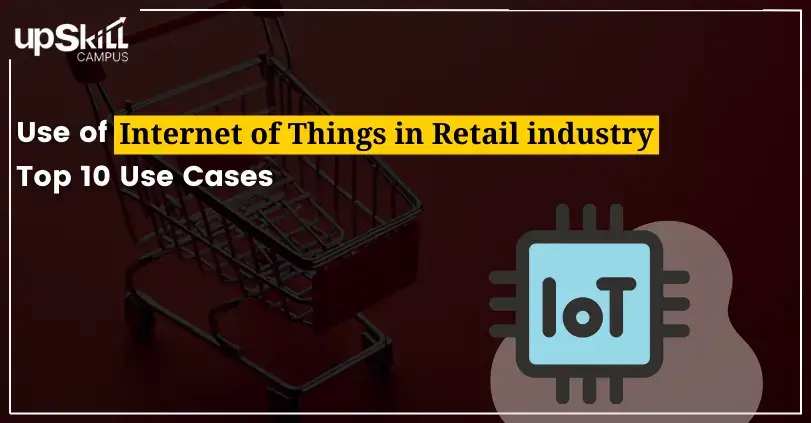List of Top 10 Different Types of Sensors in IoT With Uses

By Upskill Campus
Published Date: 5th July, 2024 Uploaded By: Shriyansh Tiwari
The internet connects everyday objects and machines. However, it’s the basic idea behind the Internet of Things (IoT). It uses tiny sensors to collect information from our surroundings, like temperature or motion. As a result, this data helps businesses run smoother by automating tasks and making savvier decisions. This blog will explore the different types of sensors in IoT.
What is a Sensor in IoT?
Tiny sensors are like the eyes and ears of the Internet of Things (IoT). These sensors collect real-time data on everything from temperature to movement, which businesses can use to improve their operations. Imagine factories that automatically adjust settings based on sensor data or deliveries that can be tracked in real time.
The logistics industry is a significant example of how IoT sensors make a difference. Many categories of sensors in IoT are there that help to track shipments, monitor storage conditions, and even optimize delivery routes. By using these sensors effectively, logistics companies can ensure their operations run smoothly and efficiently. If you're in the logistics business, consider partnering with professionals to help you set up an IoT system that can take your operations to the next level.
Types of Sensors in IoT
The Internet of Things (IoT) connects devices to the internet. But how do these devices know what's going on around them? Tiny sensors act like little spies, measuring temperature, movement, and air quality. These have types of IoT sensors, like ones that detect smoke or track how much liquid is in something.
- Temperature Sensors
- Accelerometer Sensors
- Pressure Sensors
- Biomedical Sensors
- Gyroscope Sensors
- Smoke Sensors
- Motion Detection Sensors
- Proximity Sensors
- Air Quality Sensors
- Optical Sensors
Here, we have provided you with an overview of all the IoT types of sensors. Now, we will detail them.
#1. IoT Temperature Sensors
A tiny operative that can sense how hot or cold something is a temperature sensor, a significant part of the Internet of Things (IoT). These sensors can be stuck on almost anything, from your phone to a truck full of food. They measure the temperature and send that info to a computer, which can then take action.
For instance, a truck carrying medicine can ensure that the medicine stays adequately refrigerated. If it gets too hot, the sensor can send an alert so someone can fix the crisis. Temperature sensors are also used in smart homes to keep things comfy and by farmers to know when to water their crops. We'll explore the uses of these tiny types of sensors in IoT in the next part of this blog.
#2. Accelerometer Sensors
Remember those early iPhones that could switch the screen from portrait to landscape? That trick was used by a tiny sensor called an accelerometer. It detects how you tilt or move your device. But accelerometers have many more uses than just phone screens.
These sensors can measure how fast something is moving. As a result, it makes them more useful in all sorts of things, from airplanes and missiles to fitness trackers and even cameras. They can help keep things stable, track your workouts, and even prevent theft from stationary objects.
#3. Pressure Sensors
Pressure Sensors are one of the types of sensors in IoT. They are a tiny detective that can sniff out the slightest pressure change. These little devices measure how much pressure is being applied, and if it goes above or below a certain level, they send an alert.
Pressure sensors are just like the silent guardians in many industries. In addition, they keep our homes safe by finding leaks in pipes before they cause significant damage. They ensure airplanes fly smoothly by monitoring air pressure, and they help oil companies drill efficiently by tracking pressure underground.
#4. Biomedical Sensors
Biomedical sensors are the savvy IoT sensors. They are tiny gadgets inside your body that whisper health secrets to your doctor and revolutionize healthcare.
These sensors are competent enough to measure various bodily functions such as heart rate, blood sugar levels, and blood oxygen levels. The real-time data collected from these sensors assists doctors in diagnosing illnesses, monitoring patients' health, and providing the most effective treatment.
Medical sensors are like little spies for your doctor. They can be used by athletes to prevent injuries, help people manage chronic conditions from home, and even detect diseases early on. These tiny tech icons are making healthcare savvier and more effective.
#5. Gyroscope Sensors
For example, a sensor so powerful it can detect even the slightest spin, a movement you might not even notice. As a result, this is one of the IoT-based sensors, a gyroscope sensor. It works alongside accelerometers (which sense movement in a straight line) to give devices a complete understanding of how they're moving.
These tiny gyroscopes come in different flavors, each with its superpower. Some are precise and used in spaceships and airplanes for perfect navigation. Others are less advanced but still amazing, making your car navigation smooth. Moreover, it stabilizes camera shots that are on your phone and even lets you play games with realistic movements. Gyroscopes are behind the scenes in many ways, making our tech experiences more accurate, immersive, and just plain fun.
#6. Smoke Sensors
Those beeping alarms you see in buildings are like guardian angels, watching for fire and smoke. They have tiny sensors inside called smoke sensors. These sensors are the most sensitive and can detect even a wisp of smoke or harmful gas. Moreover, they are also known for wireless IoT sensors.
When a smoke sensor detects danger, it sends a signal to a control panel. This "brain" then kicks into action, setting off alarms, unlocking doors, and even turning on exhaust fans to clear smoke. Smoke sensors are like firefighters on duty 24/7, keeping us safe in homes, offices, factories, and even vehicles.
#7. Motion Detection Sensors
Those little sensors in your home security system are the types of sensors in IoT. They're the eyes that keep watch when you're away. These motion sensors use invisible rays or waves to detect movement, like a silent alarm system.
Motion sensors are essential not only in homes but also in many other places. They can turn on lights when you walk into a room, open doors automatically as you approach, and even trigger security cameras to record only when there's movement. Along with that, they can even use in fitness trackers to count your steps and track your activity.
These tiny gadgets are the invisible helpers, making our lives more convenient, secure, and energy-efficient.
#8. Proximity Sensors
Proximity sensors are tiny gadgets that use invisible fields to detect when objects are nearby. In short, they use wireless IoT sensors in many places. They can:
- Help you find parking at the mall by guiding you to empty spots.
- Make your car safer by beeping when you're reversing and getting too close to something.
- Open trash can lids automatically as you walk by.
- Trigger ATM screens to light up when you're ready to use them.
- Even send you special offers from stores you walk past!
Proximity sensors work alongside GPS technology to make our lives more convenient, safe, and efficient. They're tiny but mighty tools for the modern world.
#9. Air Quality Sensors
Air Quality Sensors is a tiny gadget that sniffs out the air, checking for pollutants and keeping you safe. Moreover, they are also used in industrial IoT sensors. These little devices are like air detectives, measuring things like dust particles, chemicals, and humidity.
Air quality sensors are on the job in many places:
- Factories: Protecting workers from breathing in harmful fumes or dust.
- Cities: Giving real-time air quality reports to residents and governments.
- Homes: Working with heating and air conditioning systems to keep the air inside clean and healthy.
By monitoring the air we breathe, these tiny sensors play an ample role in keeping us healthy and our environment safe.
#10. Optical Sensors
Optical sensors are one of the types of sensors in IoT. Moreover, they are the tiny eyes of machines, using light to measure and detect things in the real world. They're significant because they're not bothered by electrical zaps or interference.
Real-World Examples of IoT Sensors
Here are some IoT sensors examples:
- Smartphones and laptops: Adjusting screen brightness based on how bright it is around you.
- Factories: Sorting items by color or counting things on a production line.
- Grocery stores: Scanning barcodes at checkout to make shopping faster.
- Hospitals: Helping doctors see inside your body with endoscopes and other medical equipment.
These little light-reading gadgets are everywhere, making our lives easier, safer, and more efficient.
Concluding Thoughts
The world of sensors is vast, and all the types of sensors in IoT play different and unique roles. From tiny accelerometers in our fitness trackers to smoke sensors keeping us safe in our homes, they collect data and trigger actions that make our lives better. From air quality monitors ensuring we breathe clean air to proximity sensors guiding us to open parking spots, sensors are revolutionizing the way we interact with the world around us.
Frequently Asked Questions
Q1.Where are IoT sensors used?
Ans. Tiny gadgets stuck on machines in factories, trains, and power plants. These are IoT sensors that constantly collect data on how the machines are working. However, this information helps businesses predict when things might break down, fix problems before they happen, and keep everything running smoothly.
Q2. How many IoT sensors are there?
Ans. As of 2024, there are approximately 16.7 billion connected IoT devices globally. This number reflects the rapid growth and widespread adoption of IoT technology across various industries.
About the Author
UpskillCampus provides career assistance facilities not only with their courses but with their applications from Salary builder to Career assistance, they also help School students with what an individual needs to opt for a better career.





Leave a comment